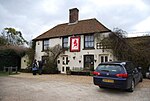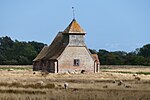Appledore railway station
1851 establishments in EnglandDfT Category F2 stationsFormer South Eastern Railway (UK) stationsGrade II listed railway stationsRailway stations in Great Britain opened in 1851 ... and 4 more
Railway stations in KentRailway stations served by Govia Thameslink RailwayTransport in the Borough of AshfordUse British English from August 2015

Appledore railway station is a Grade II listed station east of Appledore in Kent, England. It is on the Marshlink line, and train services are provided by Southern. The station was constructed in 1851 by the South Eastern Railway and designed by William Tress. It became a junction station in 1881 when a branch line opened to Lydd and New Romney; this closed to passengers in 1967 following the Beeching Report, though the line remains open for goods traffic to Dungeness Nuclear Power Station. Despite a recommendation in the report that Appledore should also close, it has remained open into the 21st century.
Excerpt from the Wikipedia article Appledore railway station (License: CC BY-SA 3.0, Authors, Images).Appledore railway station
B2080,
Geographical coordinates (GPS) Address Nearby Places Show on map
Geographical coordinates (GPS)
| Latitude | Longitude |
|---|---|
| N 51.033 ° | E 0.8164 ° |
Address
B2080
TN26 2DF , Appledore
England, United Kingdom
Open on Google Maps







